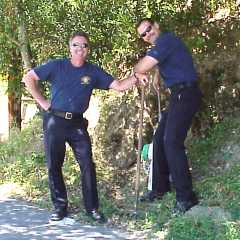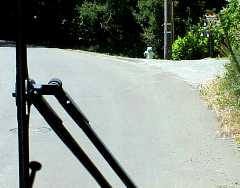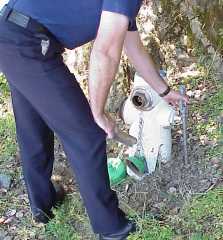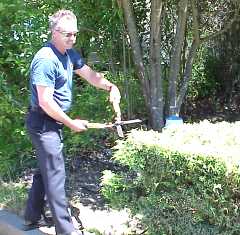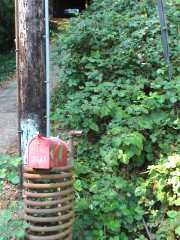© 2001 Capt. Willis Lamm, Water Supply Officer, Moraga-Orinda (CA) Fire District |
| INSPECTION PROGRAM MISSION STATEMENT |
| The District's Hydrant Inspection Program shall ensure that every hydrant in the district can be expected to perform properly and reliably whenever it may be needed in an emergency. |
| INTRODUCTION |
|
NFPA standards call for all public fire hydrants to be inspected on a
regular basis. We perform annual inspections not only for the purpose
of complying with the standards, but we need to have a high degree of
confidence that all hydrants will perform properly in an emergency.
A number of circumstances can affect a hydrant's performance which includes vandalism, accidental damage, wear and tear, mechanical malfunction and even contractors performing work on water lines who forget to reopen hydrant tap valves. We want to detect any of these problems and correct them prior to the hydrant being needed. |
| HOW THE INSPECTION PROGRAM WORKS |
|
Prior to summer fire season each company is assigned a proportional share of hydrants to inspect.
Checklists are provided. Companies perform basic servicing and preventive
maintenance. Hydrants requiring more significant work will be referred to
summer Reserve Program personnel or EBMUD (the water district) as appropriate.
Companies are supplied with basic materials such as spray paint, lubricant and hand tools. Having companies perform this work not only ensures a relatively high standard of quality and reliability, but the companies become familiar with some of the quirks and nuances of hydrant installations in the urban-wildland interface environment. |
A job best done before the
|
| INSPECTION PROCEDURES |
|
Procedures outlined in the checklist include:
LOCATION The hydrant location actually witnessed in the field should match the address given on the checklist. The hydrant should also be plotted correctly on District maps. Occasionally new hydrants are not picked up by the Mapping Program. Also as lots are developed in areas that are not completely built out, a new structure may be built between the closest preexisting "reference address" which is listed in the data base. Errors can be noted and corrections sent in to the Mapping and Water Supply Program Supervisors. |
Making note of the
|
|
CLEARANCE
There should be no obstructions, including the ground, preventing easy coupling of hoses or turning of spanners. The hydrant should be visible from all approaches. There should be no brush or tree limbs that could interfere with anyone approaching the hydrant and attempting to connect to it or operate it. Crews should make minor corrections such as pruning and minor digging. More significant work such as heavy brush removal, significant digging, placing of retaining walls to prevent hillside soil sloughoff or the raising of bodies which are set too low should be referred for correction by submitting a repair request. UFC 1001.7.1 states: "Posts, fences, vehicles, growth, trash, storage and other materials or things shall not be placed or kept near fire hydrants, fire department inlet connections or fire protection system control valves in a manner that would prevent such equipment or fire hydrants from being immediately discernible. The fire department shall not be deterred or hindered from gaining immediate access to fire protection equipment or hydrants." |
Ground sloughoff prevents
|
UFC 1001.7.2 states: "A 3-foot clear space shall be maintained around the
circumference of fire hydrants except as otherwise required or approved."
Pruning back an encroaching hedge
|
There is a hydrant somewhere
|
|
Crews should leave the hydrants clear and serviceable.
Continue to Part Two |
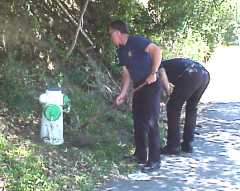
|
Return to Water Supply Index
Back to Information Section
For Related Information, Check out:
Where's the Hydrant?
|
Unless otherwise noted, all contents of these WWW pages © 1996-2002, FireHydrant.org |
